Definition
T’amar Bagrationi, Queen of Georgia (1184–1210). T’amar Bagrationi was the ninth monarch from the royal house of Bagrationis who ruled over the united Georgian Kingdom. She reigned as a co-monarch alongside her father, Giorgi III, from 1178, assuming full authority in 1184. During her reign, dynastic legitimacy necessitated the appearance of the monumental royal portraits displaying the monarch with immediate predecessors and heirs. T’amar’s gender required introduction of meticulous visual language that would re-gender her with all signs of a male ruler and justify her status and sole right to rule. This notion was embodied in her portraits that were carefully incorporated in the overall programmes of the churches. T’amar’s five monumental depictions survive where she is identified in inscriptions; two other monumental images are presumed to depict her. Of all the depictions, only one can be determined to have been commissioned directly by her. T’amar’s imagery relies on Byzantine elements and adheres to established Georgian models for the local royal portraiture; however, it also adopted sophisticated visual means that was aptly used for manifesting royal power and manipulating authority over the nobility.
1. Introduction
Queen T’amar was born in c. 1166 to King Giorgi III Bagrationi and his wife, Queen Burdukhan. T’amar acceded to the throne as a co-ruler to her father after the failed coup, which was facilitated by T’amar’s first cousin Demetre (‘Demna’) through the aid of the prominent aristocratic families. After her father’s death, she was recrowned at the demand of the clergy and nobles in 1184 (In general, about T’amar see: [1] (pp. 123–172, [2], [3] (pp. 171–237)). T’amar ruled over the united Georgian kingdom until her death in 1210 (for this date, see [4] (pp. 348–363)), alongside her second husband, Davit’ Soslan, whom she appointed King-Consort after their marriage in late 1180s and later with their son, Giorgi IV Lasha, from 1207.
T’amar’s right to succeed was challenged by traditional Georgian succession rules; her father, Giorgi III, did not hold ground for ascending the throne because he was King Demetre I’s (r. 1125–1156/57) younger son. In 1155/56, Demetre’s heir Davit’ V had forced his father into monastery by tonsuring him a monk, just to rule himself only for six months before being poisoned. On his death, he left an heir, Demetre (‘Demna’), who was still a minor. Difficulties arise when trying to establish who succeeded Davit’ V. Most historians agree on the returning of the tonsured Demetre, at that time already known as monk Daniel or Damiane. He passed shortly after regaining royal authority and was succeeded by his younger son, Giorgi, who had, as sources indicate, promised to rule only until Demna’s majority. By the 1170s, it was becoming apparent that Giorgi was not intending to let Demna rule—this resulted in a major coup, instigated by Demna and several aristocrats, which failed through the military support of peered commoners and, probably, church parties. This unsuccessful coup finally forced Giorgi to make arrangements for his succession. Soon after the 1178 coup, Giorgi, through ecclesiastical support, nominated his only daughter T’amar as a co-monarch. Shortly after Giorgi’s death, the nobility challenged Tamar’s accession to the throne, demanding to crown T’amar themselves. This recrowning confirmed T’amar’s right to rule and gained her aristocrats’ loyalty (For T’amar’s succession problems with an earlier background, see: [2] (pp. 94–97), [3] (pp. 172–178). T’amar succeeding to Georgian throne was an exception to the succession rules considering that they only recognized succession through male lineage, effectively excluding the female heirs from succeeding. Consequently, the early years of Tamar’s reign were marked with suspicion from nobles as they were much more inclined and accustomed to having a male ruler. T’amar’s exclusion from the military command furthermore complicated her position. Therefore, it does not seem surprising that the allegiance of nobles shifted towards T’amar’s first husband from an arranged marriage—the Russian Prince Yury (Giorgi), who was expected to rule by the right of his marriage to the queen.
T’amar’s initial struggle to justify her ruleship ([5] (pp. 27–39); [3] (pp. 171–172)) was not unique, as the gender-sensitive problem of a female succession also persisted in the Byzantine empire (See: [6] (pp. 104–106), [7] (pp. 9–25)) and beyond (See, [8,9]). This issue was generally problematic in thirteenth-century Georgia, Anatolia, and the Near East (See, [6]). T’amar’s accession was setting a precedent in Georgian succession rules when a female heir was not excluded from succeeding or was not substituted by her male consort. This precedent would later, in the early 1220s, support T’amar’s daughter Rusudan (r. 1223–1245) in succeeding her brother Giorgi IV Lasha, who only had an illegitimate son. T’amar and Rusudan remain the only female monarchs in Georgian history.
Although the second aristocratic coronation finally secured T’amar’s position, justifying and legitimising her rulership persisted throughout her reign. For these purposes, the crown employed court historians and theologians who constructed visual and narrative languages that could re-gender T’amar’s identity to become a legitimate ruler. Art was employed as a tool for promoting and propagating royal legitimacy and authority. This was aptly applied to the royal portraiture ([10] (pp. 98–103), [11] (pp. 12–30), [12] (pp. 93–187), [13] (pp. 288–293)), which could promote and demonstrate the royal self-fashioning and power through representation. Even though, after the 1190s, T’amar’s position seems to have been established and generally accepted, and her surviving imagery reveals careful considerations for re-gendering her image to equally ascribe her the double rights of a king and a queen (for the issue of re-gendering female rulers, see [14] (pp. 189–202)). This was also strengthened by the generalised ideological justification of female rulership, exemplified in the writings of Catholicos Nikolaoz Gulaberisdze (r. ca. 1150–1178) (See: [12] (p. 120), [3] (p. 179), [15] (p. 106)).
T’amar’s rule coincided with the period of Georgian history that the later historiography coined as the ‘Golden Age’. This age of prosperity, brought by the decades of military and economic successes, lasted until the Mongol invasions. It was furthermore strengthened by the demise of the Byzantine empire during the Fourth Crusade, allowing T’amar to interfere with international politics. At the zenith of this era, the Georgian Kingdom expanded to include the whole Caucasian region, while bordering and contacting the nearby Islamic states, acting as an international player between East and West [1]. Military success and economic prosperity ended in a cultural and intellectual flowering aptly manifested in the courtly arts (e.g., Rust’veli’s poem ‘The Knight in Panther Skin’, etc.), luxurious art commissions from the royals and aristocrats, and interests in Neoplatonic philosophy ([3] (pp. 206–237)). Moreover, this period was marked by the intrusions of Islamic influence in Georgian art (noticeably in the 1210s), witnessed mostly in Seljuk motifs and the general shift in taste (On this issue, see: [11] (pp. 109–111), [16] (p. 105), [6]).
All of Tamar’s portraits are monumental, publicly displayed images incorporated in the church decorations in Georgia: at Vardzia (1180s), Nat’limtsemeli (1190s), Q’intsvisi (1206/7), Bet’ania (after 1207), Bert’ubani (1220s—currently in Azerbaijan, posthumous) and, possibly, at Gelat’i (date: uncertain) and K’olagiri (1190s) (In general, about the imagery of T’amar, see: [10], [11] (pp. 12–30), [12] (pp. 93–187), [13,16,17,18], [19] (pp. 60–61).
2. Vardzia (1180s)
Vardzia, a cave complex, located in the southern part of the country, was the royal foundation of T’amar’s father Giorgi III. T’amar changed its probable original military function into a monastic foundation. The half-cave church of the Virgin and its fresco decoration were commissioned by Rati Surameli, a high official at T’amar’s court. The fresco decoration of this church contains the earliest image of Queen T’amar. The royal panel is placed on the northern wall of the church, inserted into a recessed arch (Figure 1). The panel shows T’amar alongside her father Giorgi III, both of them standing before the enthroned Virgin and Child. T’amar, accompanied by the inscription “King of Kings of all the East, T’amar, daughter of Giorgi; may God grant her a long life”, holds a square-shaped model of the Vardzia church and is dressed in a variation of Byzantine male imperial costume: the now blackened burgundy patterned textile skaramangion, the bejewelled loros, the red tzangia, and heavy, bejewelled crown with pendilia hanging down, while also wearing jewellery—circular earrings (on variations of Georgian royal costume, see [20] (pp. 65–89), cf. with the contemporary Komnenian Byzantine imperial dress, [21] (pp. 11–51), and the royal costume at the court of Cilician Armenia, [22] (pp. 243–259). See Glossary). Her father, accompanied by the inscription “King of Kings of all the East, Giorgi, son of Demetre, King of Kings”, wears a similar Byzantine attire, through the loros’ shape is slightly different. The royal panel also includes an image of a flying angel above the monarchs who lowers a thin sceptre to T’amar’s father. The enthroned Virgin gestures to Giorgi, while the child Christ blesses both him and T’amar. It has been noted that in this portrait, T’amar is not wearing the typical married women’s attire. Furthermore, the lack of final acclamation at the end of Giorgi’s inscription testifies that he was no longer alive. Considering all these, the panel may have been painted sometime around 1185—soon after T’amar’s second coronation or before her forced first marriage to a Russian prince. Studies have also revealed that T’amar’s face was retouched in the nineteenth century. T’amar’s portrait in Vardzia encapsulates the complicated situation at the Georgian royal court in the 1180s. The panel hints at Giorgi III’s need for legitimacy, whose usurping the throne had made T’amar’s future position vulnerable. Giorgi’s divine right for kingship is ascertained by depicting celestial powers directly investing him with the royal sceptre and by his presence before the Theotokos and child. Such positioning of Giorgi’s figure legitimises his heir and assures her succession. Furthermore, already in her earliest portrait in Vardzia, T’amar is re-gendered. Although her inscription does not omit her gender, her title, costume, and insignia remain intended for a male monarch (for these royal images and their connection with Vardzia programme, see: [10] (pp. 20–24), [11] (pp. 17–20), [12] (pp. 99–124)).
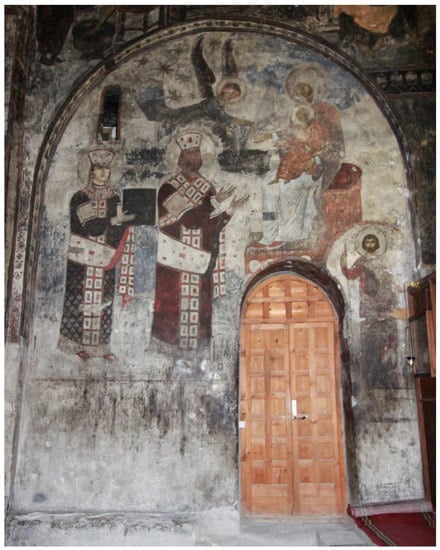
Figure 1.
Queen T’amar with her father King Giorgi III, fresco, 1180s, main church of Vardzia monastery (Photograph: Neli Chakvetadze).
3. Nat’limtsemeli (1190s)
Nat’limtsemeli—the cave monastery of Saint John the Baptist in the Gareja desert—alongside all other monasteries in this monastic region, was a ‘royal peculiar’. The monastery’s main church was decorated with frescoes in the 1190s, possibly through T’amar’s direct commission. The wall paintings contain the dynastic portraits of the Bagrationi family (See scheme of the heavily damaged portraits in [19] (Figure 10)), all attending in prayer before Saint Davit’ Garejeli, founder of monastic life in Gareja. The row of images reads from the northern wall’s eastern end. The line is led by the Catholicos’s image (tentatively identified as Nikolaoz Gulaberisdze, a twelfth-century Georgian catholicos who had contributed a theological justification to T’amar’s female rulership and had supported T’amar’s quest for church reforms) ([15] (pp. 105–107) and is followed by T’amar’s predecessor, Bagrationi, and monarchs of the united Georgian kingdom: Bagrat IV, Davit’ IV the Builder, Demetre II, and Giorgi III (as at Vardzia (Figure 1)—the monarch is offered a sceptre by an angel). The row then follows and concludes on the western wall with T’amar’s family portrait (Figure 2a,b)—a unique example in her imagery. In this panel, T’amar is depicted alongside her husband Davit’ Soslani and a young heir Lasha Giorgi, future King Giorgi IV. The figures in T’amar’s panel wear a complete set of the Byzantine imperial robes (Burgundy skaramangia (?), bejewelled and gilded loroi, red tzangia, crowns with pendilia hanging down (only T’amar’s crown survives), jewellery (rings and earrings)) and carry the labara. It should also be pointed out that, in this portrait, T’amar already wears a different crown—the Byzantine crown present at Vardzia (Figure 1) is here substituted with a much higher, pointed crown, which presumably was introduced during her reign [20]. The figures are accompanied by the inscriptions: “Tamar, King of Kings, daughter of the great King of Kings [Giorgi]”, “Davit’, King of Kings”, “Their son, Lasha”. This set of dynastic portraits was painted with great luxury—using gold and silver leaf and expensive pigments. The royal panel at Natl’lismtsemeli amplifies the themes of legitimacy and justification, already set out in Vardzia. The queen’s re-gendering still persists, even when depicted alongside her consort—both have male titles and wear male costumes (For these images, see: [12] (pp. 124–41), [17] (pp. 5–14)).
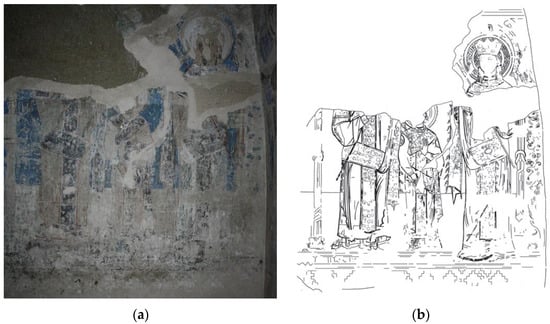
Figure 2.
(a). Queen T’amar alongside her husband, King-Consort Davit’ Soslani, and her heir, Prince Lasha (future King Giorgi IV), fresco, 1190s, main church of Nat’limstemeli monastery, Gareja desert (Photograph: Neli Chakvetadze). (b). Graphic scheme of the fresco (Zaza Skhirtladze).
4. Q’intsvisi (1206/7)
The Q’intsvisi monastery was founded by Antoni Glonist’avisdze, who was the chancellor to Queen T’amar and an influential ecclesiastic of the realm. He came to power after T’amar regained control over the Georgian Church after the death of Catholicos Mik’ael Mirianisdze in the late 1180s. Antoni commissioned the building and decoration of Saint Nicholas’s church, possibly to designate it as his burial site. The early thirteenth-century murals at Saint Nicholas’s church preserve Antoni’s donor portrait and Queen T’amar’s dynastic image. The royal panel (Figure 3) is placed on the north wall of the church’s north arm; it depicts T’amar between her predecessor Giorgi III and her heir Giorgi IV Lasha, all standing under a decorative arcade. The figures are praying before an icon panel of an enthroned Christ. T’amar and Giorgi wear a fully imperial Byzantine dress (skaramangia, loroi, ‘Georgian’ pointed royal crown, jewellery), while Lasha wears a short Georgian courtly dress. T’amar’s image is damaged, and her figure only survives as an outline drawing; no inscriptions have survived along her. Technical sophistication and expense of the Q’intsvisi murals, as suggested by the consistent use of gold and lapis lazuli, suggest luxury. The royal panel here has its peculiarities: it omits T’amar’s consort Davit’ Soslani, and her father is no more invested with a royal sceptre/labarum but now holds it. Moreover, T’amar’s heir Giorgi IV Lasha is now depicted as a grown man. It can be therefore assumed that the panel was commissioned soon after the death of Davit’ Soslani, making T’amar a widow, and shows T’amar appointing Lasha a co-monarch in c. 1206/7. Overall, the panel clearly shows that Georgian royal imagery was evolving and adapting to the shifting situation in the royal house. Giorgi III no longer needs celestial investiture; the dynastic legitimacy, blessed by Christ, is now firmly established, and grown Lasha guarantees the dynasty’s continuity. The Q’intsvisi panel shows how the commissioner of the murals Antoni—the highest-ranking individual at the court—envisioned royal power and authority and his place in their presence. Furthermore, the panel at Q’intsvisi relies on a modified scheme of the Georgian royal portraiture. Blessing figures of the Virgin or Christ are now encapsulated into frame, thus becoming icons (such type of icon ‘panel’ is also encountered in Bert’ubani, see below). This change hints towards T’amar’s and her family’s devotional aspirations This is an important aspect while studying the religiosity of royal portraiture (For this portrait, see: [10] (pp. 26–29), [11] (pp. 22–25), [12] (pp. 141–154)).
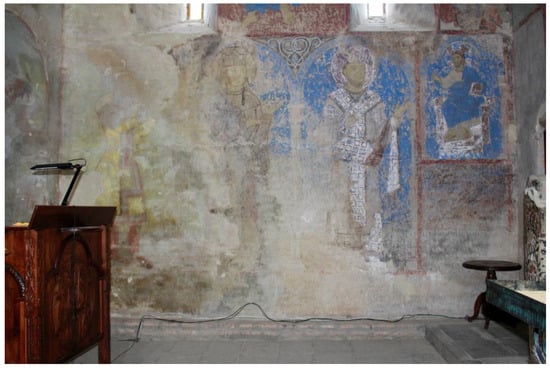
Figure 3.
Queen T’amar alongside her deceased father Giorgi III and her heir co-monarch Lasha (future King Giorgi IV), fresco, c. 1206/7, church of Saint Nicholas at Q’intsvisi monastery (Photograph: Neli Chakvetadze).
5. Bet’ania (c. 1207)
Betania, a toponym deriving from the Biblical Bethany, was a dynastic monastery of the Orbeli family. Their leading participation and support of Demna’s unsuccessful coup in 1177, resulted in the family’s annihilation by T’amar’s father. As a result, the ancestral monastery of the Orbelis was seized by royal power. In the 1200s, the main church of the monastery, which already contained a fresco decoration from the middle of the twelfth century, was redecorated and the royal panel was inserted into the programme. The scheme of this royal panel (Figure 4), located on the north wall of the north arm, repeats the pattern set in Q’intsvisi (Figure 3). Nevertheless, it is inconsistent in nature: it lacks haloes and any intercessory holy figure. T’amar is accompanied by the inscription “T’amar, King and Queen of Queens”. This is a first example from T’amar’s portraits where she is named with a double title of the ‘King of Kings’ and the ‘Queen of Queens’. This doubling is clearly indicating her position’s re-gendering completely. Moreover, it seems that her titling was pushed to limits by appropriating her title with the Christological model for the ‘King of Kings’ and combining it with the Marian title of the ‘Queen of Queens’. The composite title strengthened T’amar’s position and left no doubts for her right to rule. It was observed in the 1970s that the royal panel was heavily retouched in the nineteenth century, thus complicating the study of the original (e.g., the correct colours of the royal costumes and regalia). The royal panel was most probably inserted here for declaring monarchic authority over the Orbelis and for commemorating the presumable reconciliation between the two dynasties. This panel bears some trace of forceful insertion—causing omissions and damage to the previous programme. Although the Bet’ania panel employs the same scheme as Q’intsvisi, it is not as coherent as the latter. The panel was probably commissioned by the survining Orbelis to mark and ‘celebrate’ their obedience to T’amar and concede Bagrationis’ right to lawfully reign (For this portrait, see: [10] (pp. 24–26), [11] (pp. 20–22), [12] (pp. 154–169), [16] (p. 105)).
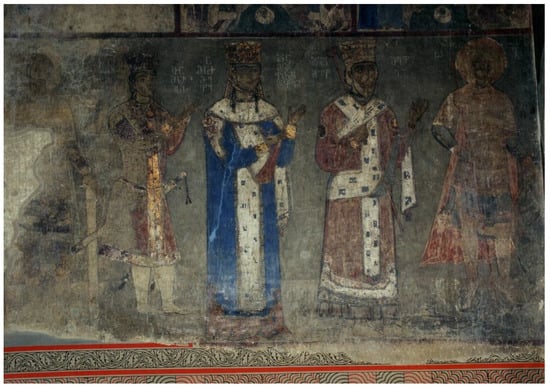
Figure 4.
Queen T’amar alongside her deceased father Giorgi III and her heir co-monarch Lasha (future King Giorgi IV), fresco, after 1206/7, church of the Virgin at Bet’ania monastery (Photograph: Neli Chakvetadze).
6. Bert’ubani (1220s)
The Bert’ubani monastery, a cave complex in the Gareja desert, currently in the territory of Azerbaijan, preserves T’amar’s only posthumous portrait. The monastery’s main church was painted in the early 1220s, right before the first Mongol invasion to Georgia. The murals were probably commissioned by the Gareja monks themselves. The fresco decoration had a royal panel on the western corner of the northern wall (Figure 5). The panel depicted the deceased Queen T’amar and her successor King Giorgi IV Lasha (1210–1223), both in prayer before an icon of the enthroned Virgin. Both Mary and Jesus bless the monarchs; T’amar is dressed in a Byzantine imperial dress (Burgundy skaramangion, bejewelled loros, a ‘Georgian’ pointed royal crown with elaborated pendilia, jewellery), while Giorgi Lasha, who in this context would be a fully ruling monarch, still wears a Georgian courtly costume; both of them wear Georgian pointed crowns with pendilia and are accompanied with the inscriptions: “T’amar, King of Kings”, “Giorgi, King of Kings, Their [=T’amar’s] Son Lasha”. The royal panel in Bert’ubani exemplifies the typical pattern that was exercised by the Georgian kings for self-fashioning: royal legitimacy was justified by joining the current monarch with his/her immediate predecessor. In Bert’ubani, the necessity for including the long-deceased Giorgi III was dropped, as T’amar’s and Giorgi Lasha’s right to rule was no longer challenged. Nevertheless, T’amar is still re-gendered here more than a decade after her death—her title and costume are still masculine. The royal panel’s remaining fragments were detached and since 1967 are conserved in the State Museum of Fine Arts in Tbilisi, in fear that the cave would collapse (For this portrait, see: [10] (pp. 29–31), [11] (pp. 25–29), [12] (pp. 169–184)).
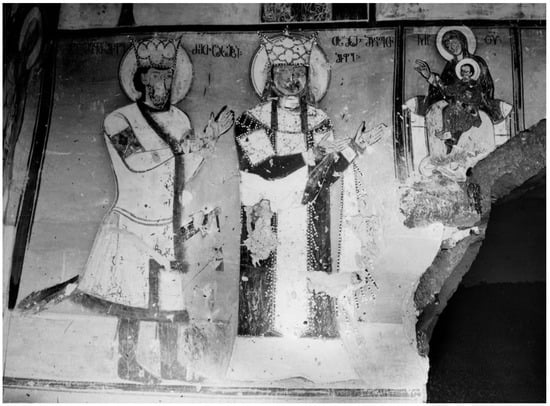
Figure 5.
King Giorgi IV Lasha alongside his deceased mother Queen T’amar, fresco, 1220s, church of the Virgin at Bert’ubani monastery, Gareja desert (Archival photograph from Zaza Skhirtladze’s collection).
7. Gelat’i (Uncertain Date)
The southeastern chapel of the main church of Gelat’i monastery, a royal monastic foundation of T’amar’s great-grandfather, King Davit’ IV the Builder, contains an intriguing image of a monarch. The figure is depicted on the western half of the northern slope of the chapel vaulting showing a monarch, clad in Byzantine royal garments (a square crown with pendilia, a divitision, a skaramangion, and a loros (of uncertain shape)) praying in front of the figure of an archangel (?). On the right side of the figure, a fresco inscription in Asomt’avruli script remains, which reads “King of Kings” (the above-mentioned recurrent re-gendered title reserved for Queen T’amar), while the monarch’s name is lost. The study of this image has revealed that the monarch has a large, rounded earing and a covered chin—the sign of a medieval Georgian married lady. The unusual placing of the image—in the vaulting—has also been noted. Considering the fact that the chapel was traditionally identified as the burial chamber of Queen T’amar (Gelat’i was itself a royal mausoleum), it has been proposed that the royal image there must have depicted her, thus being her unique funerary image (For this presumable portrait, see: [18] (pp. 505–525), [23] (pp. 223–256)—both with illustrations and schemes of the fresco). The title that is witnessed here aptly fits into Queen T’amar’s male re-gendering as exemplified by most of her portraits discussed hereby.
8. K’olagiri (1190s)
K’olagiri was a monastic foundation of the Vardanisdzes in the valley of the river Iori near the Gareja desert. Only the church and ossuary with several chambers survive. The fresco decoration of the church, commissioned by the Vardanisdze family in the 1190s, preserves a fragmented royal panel in the northern chapel, on the northern slope of the vaulting. The scene depicts Christ blessing two royal figures in ‘Georgian’ crowns; however, only the tips of the crowns survive. The presumed date of the frescoes and their connection with the Vardanisdze family make it possible to assume that the panel had shown T’amar with her consort Davit’ Soslani (For the K’olagiri monastery and presumed royal portraits there, see [24] (pp. 12–18), Figures 4 and 5).
9. Conclusions
Queen T’amar’s imagery adheres to conspicuously royal traditions in medieval Georgia; however, it also relies on apparent clothing details (costumes, sometimes schematic) from the Byzantine repertoire, including purple (see [25], “purple”). This imagery can also be characterised as a distinct group of portraits that employed a sophisticated visual language to pursue dynastic legitimation—a purpose that was crucial for T’amar’s rule. Her portraits reveal the coherent functions of monumental royal images in medieval Georgia: these were intended to be used as visual means to manifest authority and power. Moreover, the fact that the majority of these portraits were not ordered by the royal family directly (excluding the luxurious dynastic portraits at Nat’lismtsemeli, Figure 2), but by other high-ranking aristocrats, reveals different dynamics that the royal imagery could have exercised within the complicated relationship between the crown and aristocracy. Displaying legitimizing imagery of the ruling Queen may have been instrumental for asserting the nobility’s allegiance to the crown, thus revealing their support of T’amar’s lineage. Furthermore, T’amar’s royal panels manifest the evolution within her imagery, while her power and position strengthened in the kingdom. If at the beginning of her reign she could not have been depicted without the legitimising figure of her late father, by the end of her life, her father’s portrait would have only become a mere remainder of her ancestry. This pattern was finally dropped by T’amar’s heir Giorgi Lasha, whose right to rule was no more challenged. T’amar’s imagery also witnesses changes within courtly ceremonial preferences: while reserving the quasi-Byzantine male imperial costume for her depictions—as a sign of re-gendering—her predecessors’ Byzantine crown was dropped in favour of a Seljuk crown [26]. Even though the origins and reasons for this crown appearing in the 1190s still have not been satisfactorily examined, it most probably derived from the insignia of the neighbouring Seljuk states. At the same time, some of the monarch’s traditional insignia—namely the sword, which was definitely used at T’amar’s coronation, was abandoned in her official imagery, as it was definitely unacceptable for women to carry weapons in publicly displayed images, even while governing as an absolute monarch. As a whole, the visual language employed for T’amar’s imagery reveals flexibility that was exercised at the Georgian court for the plainly monumental construction of the ruler’s authority. Lastly, it should also be noted that the gender-sensitive type of the dynastic royal imagery, adapted for Queen T’amar, was unique and never again followed by followed by subsequent Georgian monarchs from the Bagrationi dynasty.
Funding
This research received no external funding.
Acknowledgments
The author would like to thank Antony Eastmond, Zaza Skhirtladze, and Neli Chakvetadze for their support in preparation of this entry.
Conflicts of Interest
The author declares no conflict of interest.
Glossary
| Asomt’avruli | Majuscule script of the Old Georgian alphabet. |
| Labarum (Pl. Labara) | Christian military standard, later adopted in Byzantium for angelic iconography and royal insignia ([25] (p. 1167)). |
| Loros | A long scarf, esp. the heavy stole about 5 m long and studded with precious stones worn by both the emperor and empress ([25] (pp. 1251–1252)). |
| Skaramangion | A belted tunic with longs sleeves and with slits up the front and back or sides ([25] (p. 1908)). |
| Tzangion (Pl. Tzangia) | Byzantine emperor’s purple shoes, one of the most revered insignia of imperial authority ([25] (p. 2135)). |
References
- Jap’aridze, G. Sak’art’velo da Makhlobeli Aghmosavlet’is Islamuri samq’aro XII–XIII s-is Pirvel Mesamedshi (Georgia and Islamic World of Near East in Twelfth—First Half of the Thirteenth Centuries); Metsniereba: Tbilisi, Georgia, 1995. [Google Scholar]
- Metreveli, R. Mep’e T’amari (Queen T’amar); Ganat’leba: Tbilisi, Georgia, 1991. [Google Scholar]
- Nikolaishvili, S. Byzantium and the Georgian World c. 900–1210: Ideology of Kingship and Rhetoric in Byzantine Periphery. Ph.D. Thesis, Central European University, Budapest, Hungary, 2019. [Google Scholar]
- Jap’aridze, G. T’amar mep’is gardatsvalebis tarighis shesakheb (Concerning the Date of Queen T’amar’s Death). Hist. Collect. Annu. 2012, 2, 348–364. [Google Scholar]
- Huneycutt, L. Tamar of Georgia (1184–1213) and the Language of Female Power. In A Companion to Global Queenship; Woodacre, E., Ed.; Arc, Amsterdam University Press: Leeds, UK, 2018; pp. 27–39. [Google Scholar]
- Eastmond, A. Tamta’s World: The Life and Encounters of a Medieval Noblewoman from the Middle East to Mongolia; Cambridge University Press: Cambridge, UK, 2017. [Google Scholar]
- Karagianni, A. Female Monarchs in the Medieval Byzantine Court: Prejudice, Disbelief, and Calumnies. In Queenship in the Mediterranean. Negotiating the Role of the Queen in the Medieval and Early Modern Eras; Woodacre, E., Ed.; Palgrave Macmillan: New York, NY, USA, 2013; pp. 9–25. [Google Scholar]
- Woodacre, E. (Ed.) Queenship in the Mediterranean. Negotiating the Role of the Queen in the Medieval and Early Modern Eras; Palgrave Macmillan: New York, NY, USA, 2013. [Google Scholar]
- Woodacre, E. (Ed.) A Companion to Global Queenship; Arc Humanities Press: Leeds, UK, 2018. [Google Scholar]
- Alibegashvili, G. Chetyre Portreta Tcaritcy Tamary (Four Portraits of Queen T’amar); Izdatel’stvo akademii nauk gruzisnkoj SSR (Georgian USSR Academy of Sciences Press): Tbilisi, Georgia, 1957. [Google Scholar]
- Alibegashvili, G. Svetskij Portret v Gruzinskoj Srednevekovoj Monumental’noj Zhivopisi (The Secular Portrait in Medieval Georgian Monumental Painting); Metsniereba: Tbilisi, Georgia, 1979. [Google Scholar]
- Eastmond, A. Royal Imagery in Medieval Georgia; The Pennsylvania State University Press: University Park, PA, USA, 1998. [Google Scholar]
- Eastmond, A. Royal Renewal in Georgia: The Case of Queen Tamar. In New Constantines: The Rhythm of Imperial Renewal in Byzantium, 4th–13th Centuries; Magdalino, P., Ed.; Ashgate: Aldershot, UK, 1994; pp. 283–293. [Google Scholar]
- Huneycutt, L. Female Succession and the Language of Power in the Writings of Twelfth-Century Churchmen. In Medieval Queenship; Parsons, J.C., Ed.; St. Martin’s Press: New York, NY, USA, 1993; pp. 189–202. [Google Scholar]
- Sulava, N. Nikolaoz Gulaberisdze, T’khzulebani (Nikolaoz Gulaberisdze, Complete Works); Svetitskhoveli Brotherood: Mtskhet’a, Georgia, 2007. [Google Scholar]
- Eastmond, A. Gender and Orientalism in Georgia in the Age of Queen Tamar. In Women, Men, and Eunuchs. Gender in Byzantium; James, L., Ed.; Routledge: London, UK, 1997; pp. 100–119. [Google Scholar]
- Skhirtladze, Z. Les portraits de l’église principale du monastère Natlismtséméli à Garedja. Zograf 1993–1994, 23, 5–14. [Google Scholar]
- Skhirtladze, Z. Another Portrait of Queen Tamar? In Anadolu Kulturlerinde Sureklilik ve Degrisim, Dr. A. Mine Kadiroglu’na Armagan; Ceren Erel, A., İşler, B., Peker, N., Sağır, G., Eds.; Ankara, Turkey, 2011; pp. 505–525. [Google Scholar]
- Skhirtladze, Z. History in Images: Donor Figures in Medieval Georgian Art. In Cultural Interactions in Medieval Georgia; Bacci, M., Kaffenberger, T., Studer-Karlen, M., Eds.; Reichert: Wiesbaden, Germany, 2018; pp. 47–75. [Google Scholar]
- Chop’ikashvili, N. K’art’uli Kostiumi (VI–XIV ss.) (Georgian Costume, Sixth to Fourteenth Centuries); Metsniereba: Tbilisi, Georgia, 1964. [Google Scholar]
- Parani, M. Reconstructing the Reality of Images Byzantine Material Culture and Religious Iconography (11th–15th Centuries); Brill: Leiden-Boston, The Netherlands, 2003. [Google Scholar]
- Evans, H. Imperial Aspirations: Armenian Cilicia and Byzantium in the Thirteenth Century. In Eastern Approaches to Byzantium; Eastmond, A., Ed.; Ashgate: London, UK; Routledge: London, UK, 2003; pp. 243–259. [Google Scholar]
- Skhirtladze, Z. Mep’et’a Mep’is Preska Gelat’is Monastris Mt’avari Tadzris Samkhret’-Aghmosavlet’ Ekvdershi. Masalebi Shesadzlo Gaigivebisat’vis (Fresco of the King of Kings in the South-Eastern Chapel of the Main church of Gelati Monastery. Materials for Possible Identification). Stud. Humanit. Annu. 2012, II, 223–256. [Google Scholar]
- Skhirtladze, Z. Istoriul Pirt’a Portretebi Garejis K’olagiris Monastershi (Historical Figures at Kolagiri Monastery in the Gareja Desert); Gareja Studies Centre: Tbilisi, Georgia, 2000. [Google Scholar]
- Kazhdan, A.P. (Ed.) The Oxford Dictionary of Byzantium; Oxford University Press: New York, NY, USA; Oxford, UK, 1991. [Google Scholar]
- Dankoff, R. Turban and Crown: An Essay in Islamic Civilization. Available online: https://www.academia.edu/13435409/Turban_and_Crown_An_Essay_in_Islamic_Civilization (accessed on 2 June 2022).
Publisher’s Note: MDPI stays neutral with regard to jurisdictional claims in published maps and institutional affiliations. |
© 2022 by the author. Licensee MDPI, Basel, Switzerland. This article is an open access article distributed under the terms and conditions of the Creative Commons Attribution (CC BY) license (https://creativecommons.org/licenses/by/4.0/).